Whether for family game night, causal play, or seriously complex games, nearly all tabletop games require dice. But the market for dice can get rather expensive or available models may not be exactly to your liking or needs, which makes 3D printing dice a great cost-effective alternative.
Some of the best ways to print them are with PLA and a high infill and resolution, but this varies on the die and the intended use, whether they’ll be rolling down a tower, over a table, or serving as decor pieces for your home.
If you need help finding dice because of the many offers out there, don’t panic! We’ve compiled 15 great 3D printed dice models that’ll suit a variety of needs. But first, let’s take a look at how we narrowed down our options and, after going over our picks, how you can design your own.
And when your 3D printer’s not up to task, consider Craftcloud. Upload your STLs, choose the material, colors, and finishes that’ll work for you and have the dice rolling to your doorstep!
Considerations
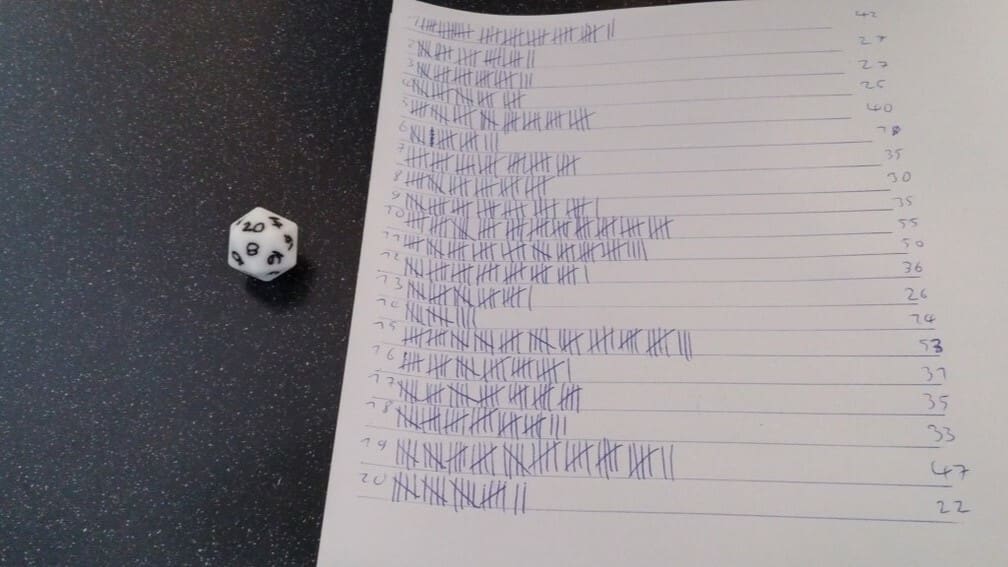
As mentioned, there are many dice designs online: some paid, some free; some generic, others dedicated to specific games or fandoms; a few designed with resin 3D printing in mind, while others may be meant for fused deposition modeling (FDM) printing. Let’s see how we narrowed down our choices.
- Rolling ability: One of the most important things when considering dice is how well they roll. They shouldn’t have a design that really affects the roll to ensure a fair and even game. So, even when the designs get really unique, the picks on this list can cruise over tables with no issue.
- Design: Another important factor when considering dice is their design. We must consider how well they are suited for 3D printing. Additionally, depending on the game you play, the dice can have a good theme to match the game you choose to play with them. So, we aimed to include a variety of themes to fit different games and printing setups.
- How good are they for games (theme, use, etc.): Dice should fit the game you play more than just theme-wise. They should be able to meet the requirements of play. This includes the number of faces, outcomes, shape, and more. Again, variety was key in narrowing down our top picks to address as many of these as possible.
- Price: The last consideration when 3D printing dice is how much they cost. You’ll be glad to know that in our search for the best dice, we made sure to select only free-to-download models. This ensures that as long as you have a 3D printer or have access to a 3D printing service, you can download the files and have the dice ready to roll in no time.
With the above considerations in mind, let’s take a look at our 15 picks of 3D printed dice, after which we’ll go over how to make your own designs.
Facets
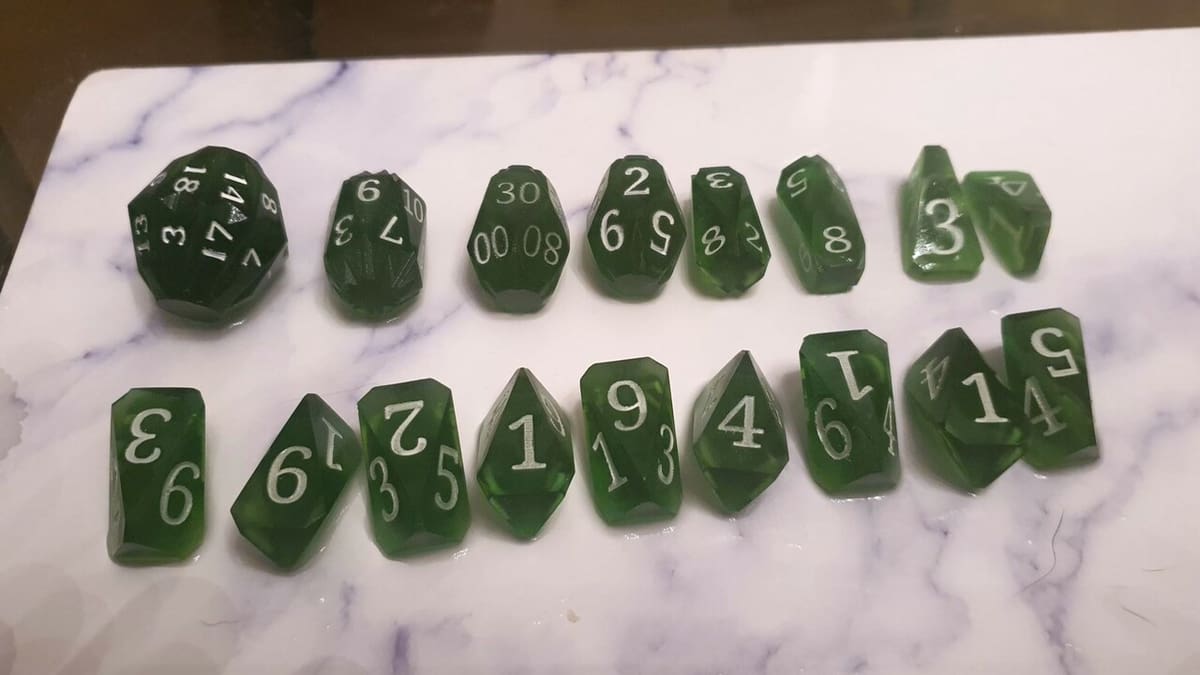
Facets is a term for the many sides of something, usually a gemstone. And these dice show it. These Facet dice have cool cuts that make them look like they were just cut out of a precious stone, which also makes rolling more interesting. Additionally, the set has d4-d20 dice to make a full set.
The creator printed these with PLA, without supports but with a raft, with 100% infill, and 0.16-mm layer height. To make them more realistic, you can use transparent PLA or clear resin and paint the numbers.
- Who designed it? sablebadger
- How printable/popular is it? It has almost 70,000 downloads, over 35 makes, and 2 remixes combined from both sites, numbers that clearly speak of the designs’ popularity.
- Where to find it? Thingiverse, MyMiniFactory
D&D Set with Outset Numbering
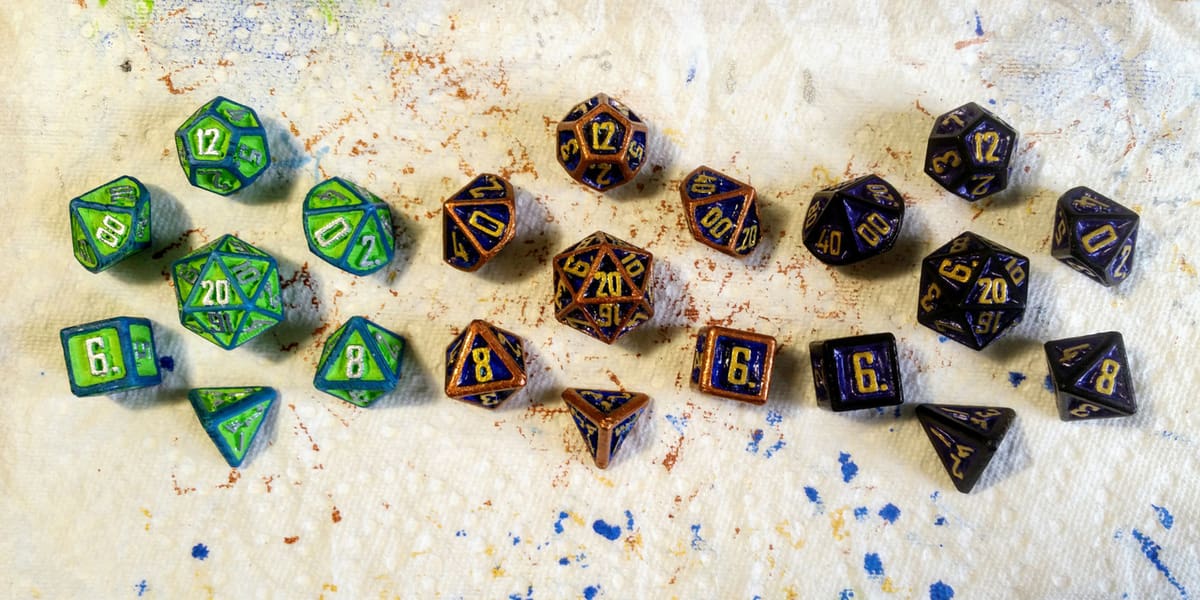
These dice are great for a game of D&D. Whether for beginners who are starting their dice collections or for seasoned players who want to update theirs, these are great for going on an epic journey.
This set includes dice from d4-d20, so you should have everything you need to get started or for plenty of different games.
Among the printing recommendations, the designer includes the use of supports, with a maker specifying tree style to make them easier to remove. For painting these dice, the creator recommends sanding them and then coating them in your chosen color of acrylic paint and varnish.
- Who designed it? noy-nac
- How printable/popular is it? These dice have been downloaded around 10,000 times, are part of 42 collections, and have 2 shared makes from both sites combined.
- Where to find it? MyMiniFactory, Thingiverse
Balanced
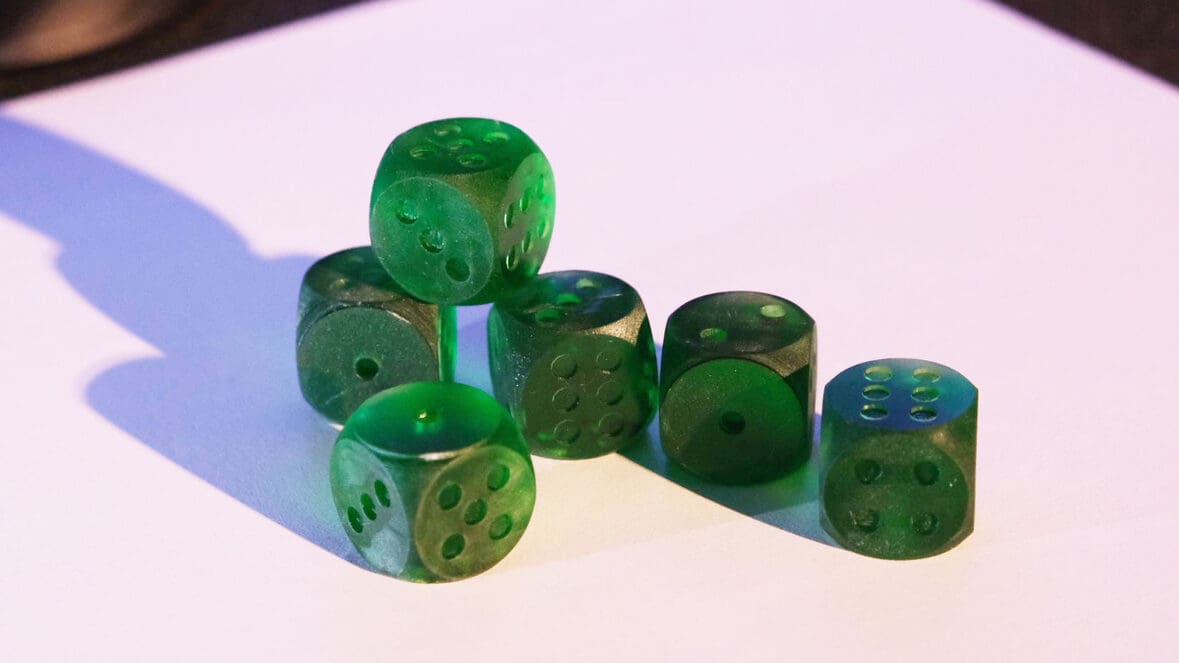
These dice are specially designed to have a perfectly even roll for casual board games. The creator of these achieved it by making each piece have the exact same amount of material missing from each side, which should lead to the dice being more balanced than regular designs. This would allow for a true one-in-six chance when rolling.
The dice are your standard six-sided dice, making them good for traditional board games. While the designer didn’t specify any printing settings they used, commenters mention opting for a 100% infill, although other makers mention other ideas – they’re all worth checking out!
- Who designed it? RarelyEvil
- How printable/popular is it? It has 70 makes, 9 remixes, and 70,000 downloads, which speak of the designs’ popularity and printability.
- Where to find it? Thingiverse
QR (DI)
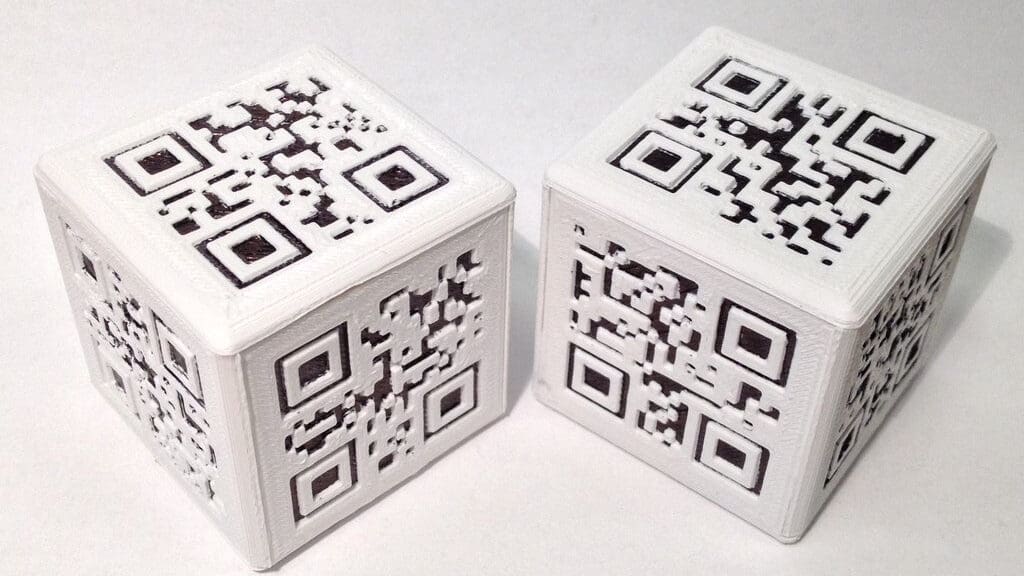
These dice add a new and interesting way to read them: They do this by having the player scan a QR code to get their result.
The creator recommends that the faces be printed separately, without supports, and later glued together. Additionally, the printer must be very well-calibrated in order to make the QR codes scalable. After printing the faces, the maker recommends coloring them in Sharpie or another kind of black paint to make them easier to scan.
Monster
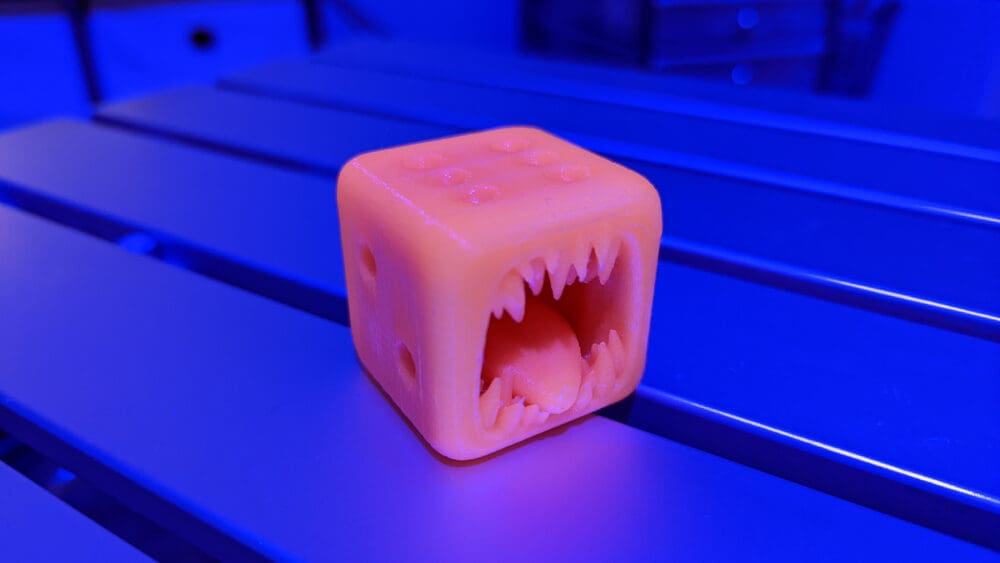
If you’re a D&D player, you know about the hard-to-see foes, mimics, that shape-shift into unsuspecting objects. Unlike in the game, it’s clear that the die pictured above is a mimic.
This is a set that includes d4-d12 mimic-themed dice.
These dice replace one of the sides with a mimic face, which adds immersion to your D&D games. To bring out the true monstrosity that the mimic is, you can paint them to add greater detail and spookiness, as some makers have done.
The designer opted for a 0.15-mm resolution and 30% infill, and most of the makers who opted for FDM share similar values, so they should do the trick.
- Who designed it? Kohlbush
- How printable/popular is it? The model has 30,000 downloads, 19 makes, and 3 remixes.
- Where to find it? Thingiverse
Rounded Platonic
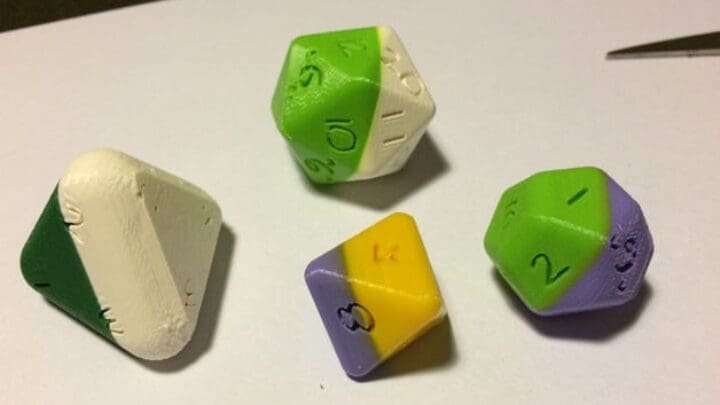
For those who are history buffs, you could easily recognize these dice as Platonic Dice. For those who don’t know, these are the same kind of dice that were used in ancient Greece, thousands of years ago.
To aim for the same rolling quality as the Greeks, print these with a high amount of infill (70%-100%).
It’s worth noting that, as some commenters mentioned, the numbers appear to be on the wrong faces, yet this hasn’t deterred people from printing them.
- Who designed it? pmoews
- How printable/popular is it? The files have around 21,000 downloads, while 12 makes and 3 remixes have been shared so far.
- Where to find it? Thingiverse
Geartech D8
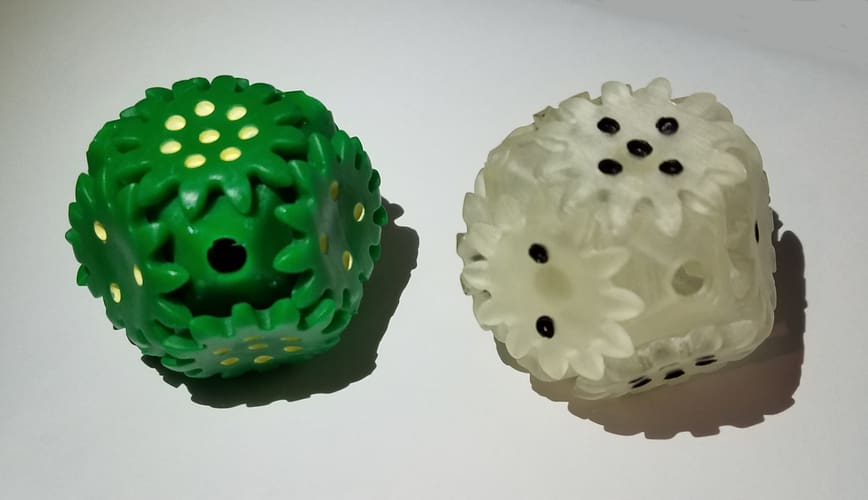
For those who have a problem sitting still when playing tabletop games, these dice are perfect. They have a mechanism that makes the sides spin, making them a great fidget toy. They’re also themed for mechanical-themed board games.
The model comes in three different versions: One with supports, one without, and a newer version with supports. After printing these, consider using lubricant during assembly.
- Who designed it? TishToshTesh
- How printable/popular is it? The model has gathered over 1,000 views.
- Where to find it? Pinshape
Cogs D&D (Industrial/Steampunk)
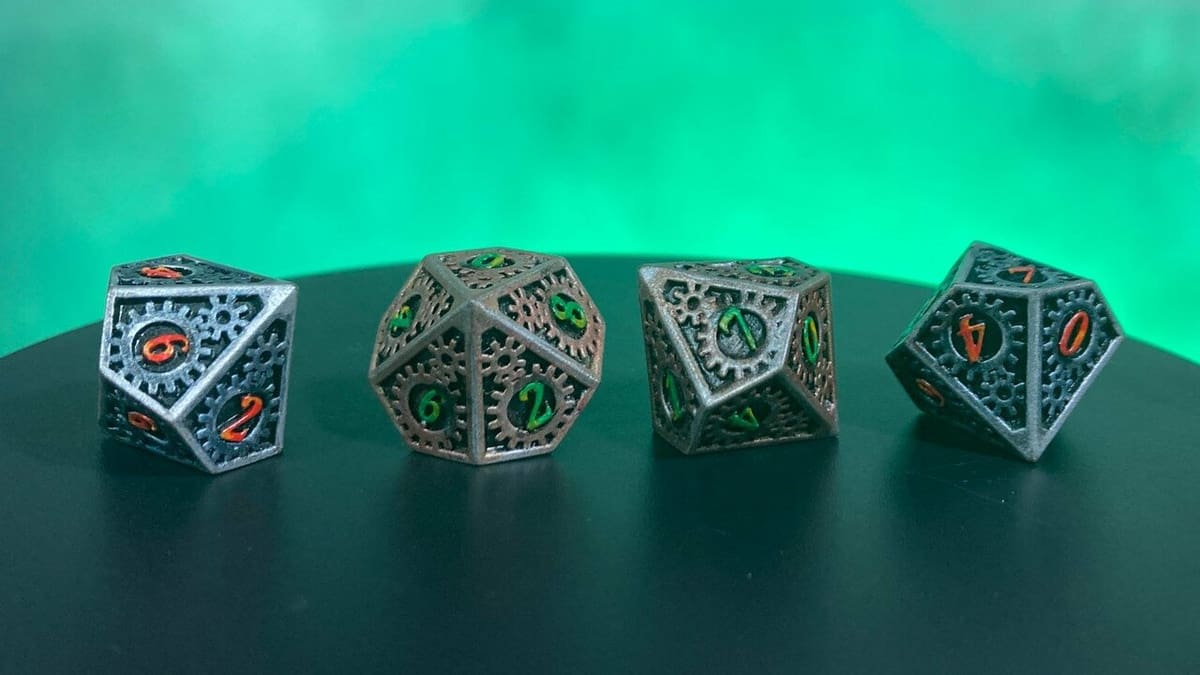
For those who like steampunk or industrial-themed games, these dice are great because they have a well-designed steampunk theme. The collection features a d6, d8, d10, d% (d100), d12, and d20. Additionally, there’s a truncated tetrahedron for the d4 die.
In spite of the detail and complexity, printing shouldn’t be that complicated and neither supports nor a raft are required. If you have an FDM printer, you can modify it to print metal PLA for a more realistic look.
- Who designed it? yolwoocle
- How printable/popular is it? These dice have 10,000 downloads, 8 makes, and 2 remixes.
- Where to find it? Thingiverse
Sphere
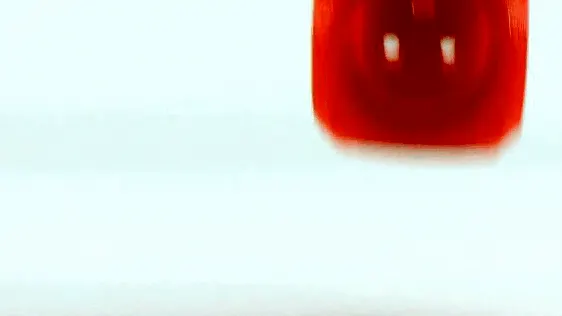
To mix up the stereotypical 6-sided die, Cults designer ideamx made the Sphere Die. This die has a unique shape, and while it looks intriguing, it doesn’t affect the rolling of the die in any negative way.
To add to its uniqueness, the opposite sides don’t add up to 7.
While the creator doesn’t include any printing tips, should there be print failure due to overhangs, for example, tree supports may do the trick.
Set (D4-D30)
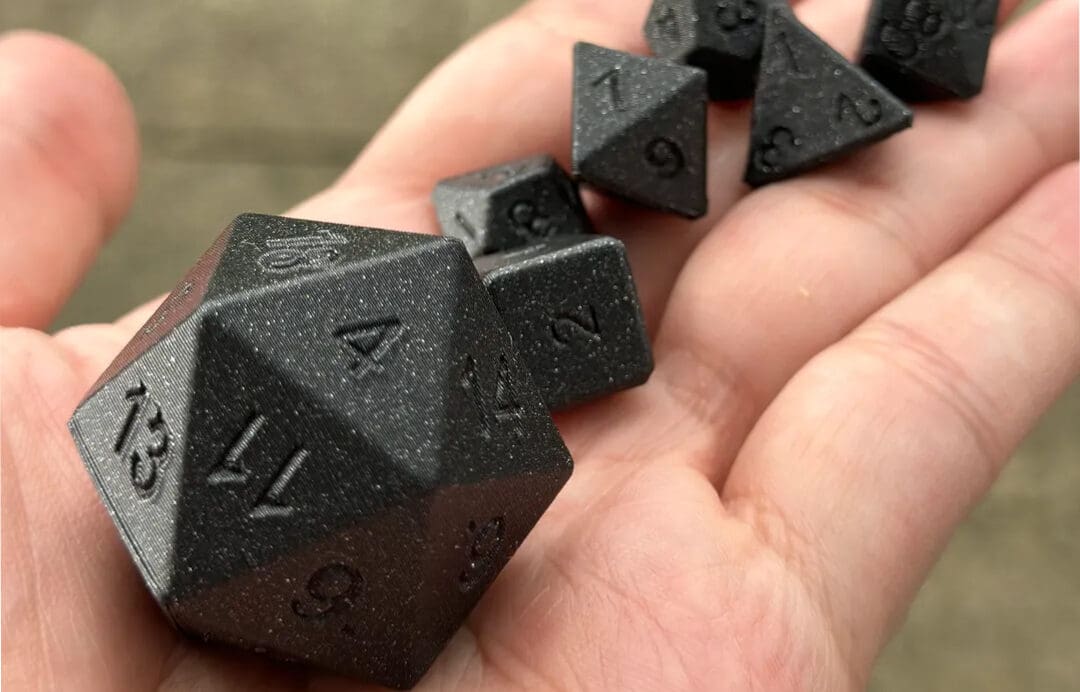
This is a simple yet clean design for an almost full set of dice. The set ranges from d4 to d30, and all have very nice model quality. They can be individually printed, making it so you can easily get the exact dice you need for your games, be it to complete your collection or if you just want to print one lucky die.
There are no specific printing instructions, yet a maker opted for 100% infill, while another split the d30 die before printing and then glued the parts. Some comments and makes suggest that you should paint the numbers with subtle colors to make the numbers stand out.
- Who designed it? MSscribbles
- How printable/popular is it? The dice have 14 makes, are part of 225 collections, and have been downloaded over 1,800 times.
- Where to find it? Printables
Cracked RPG Set
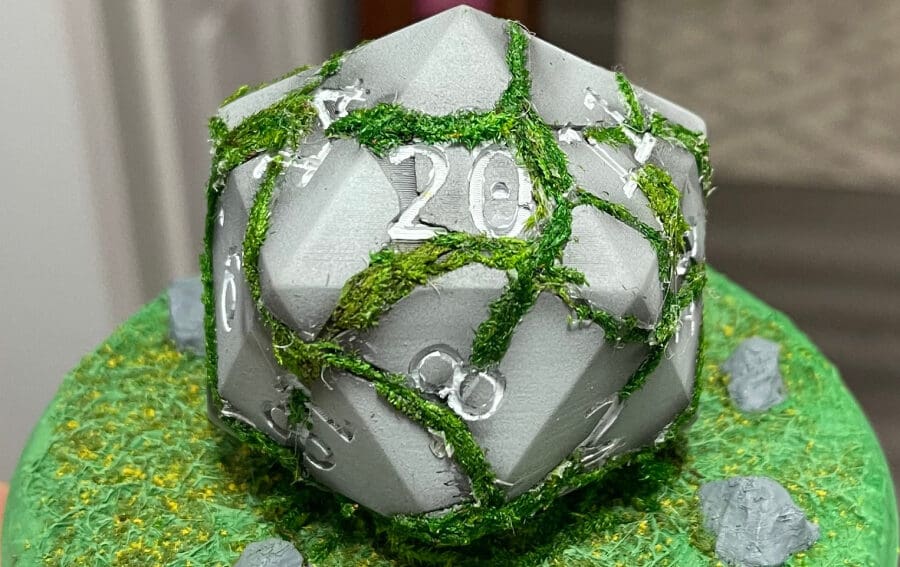
These uniquely designed dice are great for matching the theme of classic D&D campaigns. They resemble carved and cracked stones, and as can be seen in the photo, can be painted to have shrubbery or finer detailing. The set runs d4-d20, which contains most of the dice for playing D&D.
You should print these with a relatively low layer height to get as much detail as possible, and 100% infill to make them roll well.
- Who designed it? south2012
- How printable/popular is it? These RPG dice have 43,000 downloads and 22 impressive makes shared.
- Where to find it? Thingiverse
D60
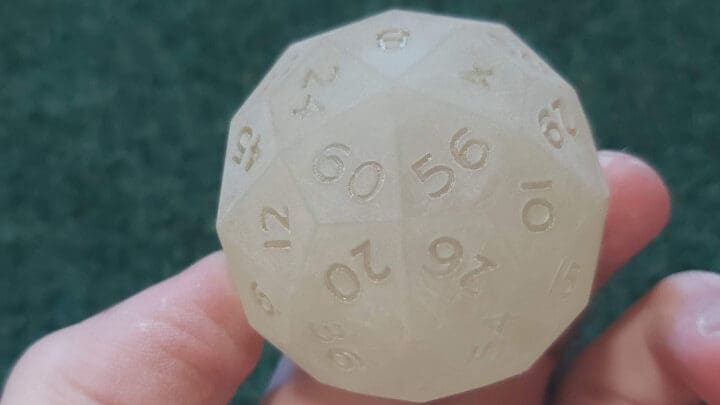
For people who want the most randomness in their games, this die is great. It has a whole 60 possible outcomes when rolling.
The model is well-made, and its size will result in a good and fun roll. The letters have a depth of 0.6 mm, so you don’t need to paint the numbers unless you use a dark filament that might make it tricky to read.
Supports shouldn’t be necessary, although minimal tree ones might help if there are any issues, and at least 70% infill should do the trick.
- Who designed it? PrintCastandRoll
- How printable/popular is it? The massive D60 has over 1,200 views and 125 downloads.
- Where to find it? MyMiniFactory
Futuristic
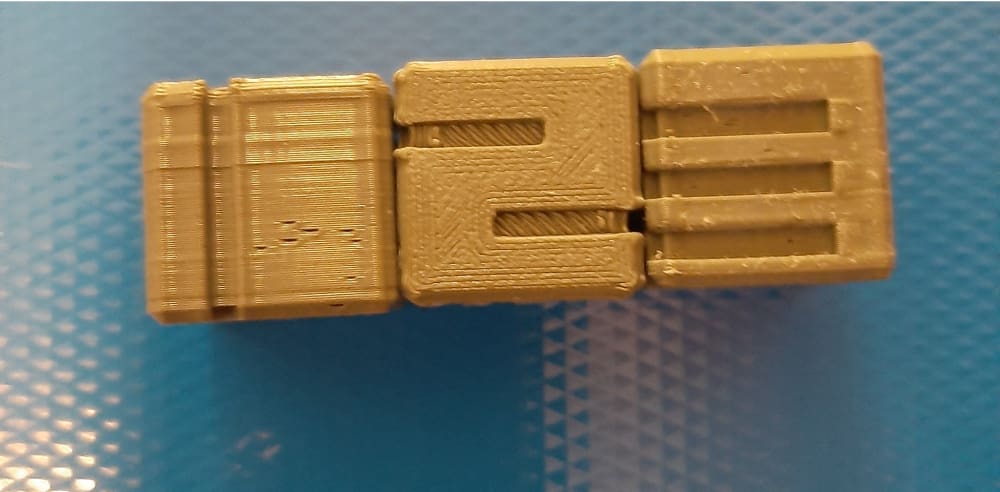
For people playing sleeker board games, these dice are great. They have a clean and unique design, representing a futuristic theme. Unlike other dice, the numbers are directly stated on the die but have a good design to fit the theme.
Print this with 90% infill, 200% resolution, and no support. Although, some comments recommend a 100% infill for a more distributed roll.
- Who designed it? rh99
- How printable/popular is it? This sleek model has over 3,600 downloads and 4 makes combined from both sites.
- Where to find it? Thingiverse, Printables
Runic

This runic 6-sided die is great for Viking-themed board games and D&D campaigns. Its rounded design should offer good rolling on flat surfaces. The runes are from old Vikings, but you can assign any number or outcome to them you’d like.
The designer opted for a 0.15-mm layer height and a 15% infill printed in PLA to make this die, so these settings should work for your take too! That said, for a sturdier die, a bit more infill might also be warranted.
- Who designed it? Papiertier
- How printable/popular is it? This model has been downloaded around 150 times and it has over 1,800 views.
- Where to find it? Cults
Tactile Braille
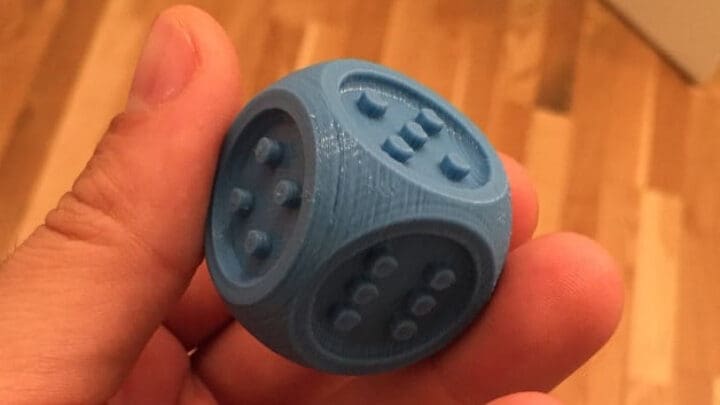
If you want to play board games with visually impaired family and friends, these dice will allow them to play without issue. The designs have extruded numbers, which are readable in braille.
If you decide to print this model, we recommend a 90% infill, 0.1-mm layer height (or as low as possible to get the most detail out of the numbering), and no supports should be necessary.
- Who designed it? Zulloc
- How printable/popular is it? This model has been downloaded over 3,000 times and 5 makes have been shared so far.
- Where to find it? Thingiverse
DiceMaker
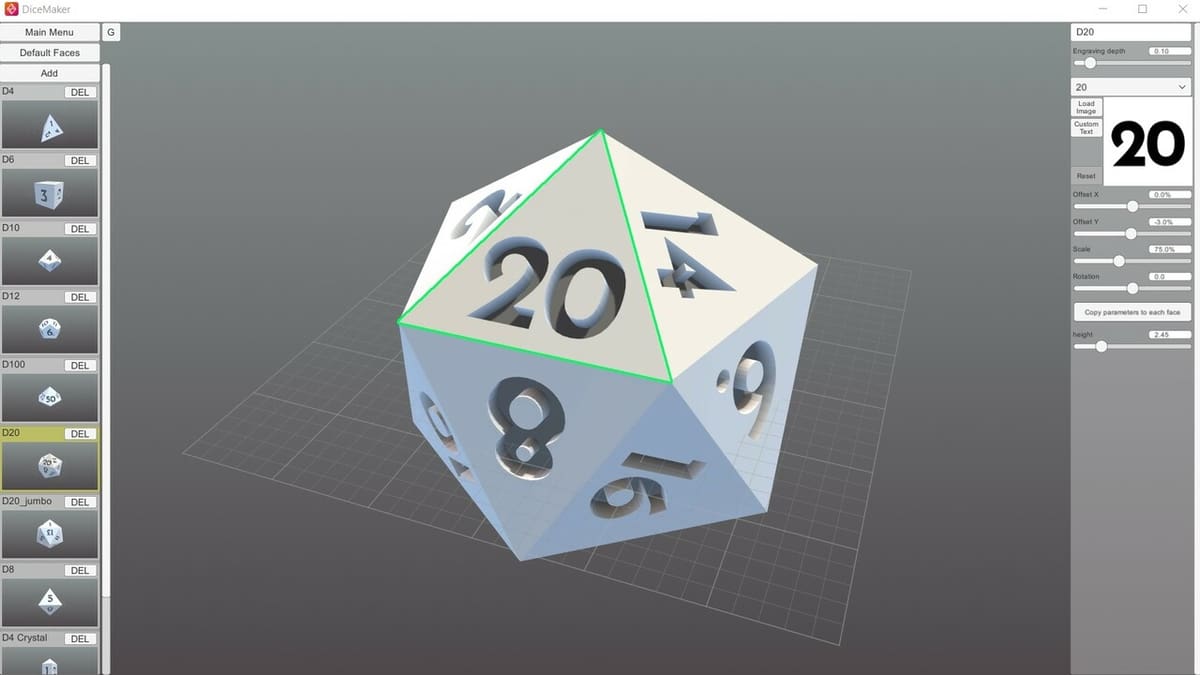
If you’re not sold on any of the previous dice or you’ve got an idea in mind that you’d like to create yourself, you can always turn to a program to help you out. While you could start with great options like the beginner-friendly Tinkercad or the more advanced Blender, opting for an app that’s dedicated to making dice will make your life easier.
And here’s where DiceMaker rolls in. It’s a free app that’s compatible with Windows and Linux.
Once you’ve got it running on your device, you can start the program and add a die. After deciding on the type (e.g. D20), you can select the typography (you can add a TTF font file) and you can customize the text as well. In addition to changing the numbers, you can scale them up or down and change the depth of the engraving.
DiceMaker is great for creating your own dice: You can use any font, image, or number for any of the faces, and almost every dice shape is available on this app. You can choose from almost every combination of faces and even choose whether or not the numbers are extruded or not. You then export it in an STL format.
For a thorough guide, check out DiceMaker’s documentation, which includes key shortcuts and more information to help you get started.
Overall, this program is easy to use and will allow you to make any custom die you want.
License: The text of "15 Amazing 3D Printed Dice for Board Gamers" by All3DP is licensed under a Creative Commons Attribution 4.0 International License.


